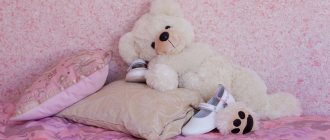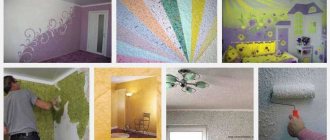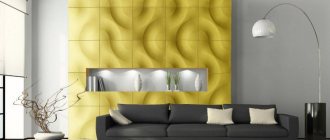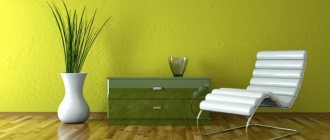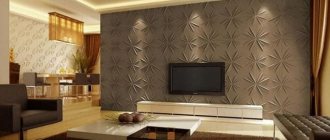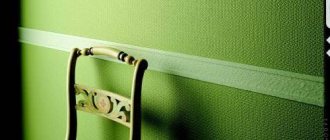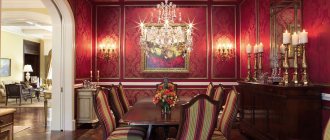Savig
8522 0 6
Savig October 26, 2017Specialization: master of interior finishing works. I am well versed in power tools for repair and construction. Formerly a teacher at a radio engineering college.
With the right approach, when combining panels with wallpaper, you can get an excellent result
Is it possible to glue wallpaper on PVC or MDF panels? In search of answers to this question, I propose to consider the features and instructions for combining these finishing materials. Visual illustrations will help you understand everything.
Combination of finishing materials
Why combine at all, if, for example, you can simply install panels instead of wallpaper on the wall and not spend additional money on the canvases themselves? Or, on the contrary, don’t bother with installing plastic or wooden sections, but traditionally use paper cladding, which will be even cheaper? This is because both types of these finishing materials complement each other favorably, which more than compensates for the extra expenses:
- Wallpaper decorates the panels . The incredible number of colors and patterns offered by paper or vinyl sheets provides the designer with a much wider range of options compared to plain sections made of PVC or medium-density fiberboard;
Photo of a display window in a wallpaper store, clearly demonstrating the range of products offered
- The panels create an ideal base for wallpaper and open up new zoning possibilities . Paper sheets fit perfectly on a smooth and hard surface, not like cracked plaster or bumpy concrete. In addition, it becomes possible to combine a section not only on the wall, but in any part of the room.
A false wall made of panels and wallpaper will help divide the living room into two different functional areas
In addition to the fact that wallpaper can be glued to wall panels, it can also be glued above them. This gives two positive aspects: firstly, the room is visually stretched upward, and secondly, the lower and more vulnerable part of the wall receives better protection.
When combining two different materials, you should run the wallpaper under the panels, then the place where they meet will not be externally noticeable
So, as you can see, if the slightly higher price of this method of interior design does not stop you, you can safely use it: the result will be both beautiful and practical.
Wallpaper and PVC panels
Is it possible to glue paper sheets to PVC wall sections? The answer is affirmative, but with some caveat: the process is possible only if certain preparatory work is completed. We will look at them now:
| Photo | Instructions |
| Let's prepare: |
- Primer for plastic surfaces;
- Adhesive primer;
- Roller;
- Solvents or other mixture with similar properties;
- Fine-grained sandpaper.
As you can see, the main difficulty when combining paper sheets with plastic is to strengthen the adhesion of the base, which in its initial form is very weak.
It is not possible to reliably glue something onto glossy plastic without proper pre-treatment.
Is it possible to glue plastic panels to wallpaper? In this case, small PVC inserts are used to create certain accents.
I recommend framing such inserts with decorative baguettes. They will create the illusion of an unusual art gallery.
Plastic fragments against the background of plain wallpaper look like paintings by some avant-garde artist
Wallpaper and MDF panels
Is it possible to put wallpaper on MDF panels? In this case, everything is much simpler and more positive than in the case of plastic sections, since this material is small wood shavings pressed under conditions of high temperature and humidity. That is, it has almost the same properties as wood, and paper sheets stick to it quite well.
Medium-density fiberboard can be covered with paper sheets as easily as a wooden wall
MDF panels can also be glued to wallpaper, forming various fragments, as discussed above with plastic sections. And even more than that, you don’t have to limit yourself to just inserts; you can create alternating stripes of trim from different materials. In this case, the following rules should be adhered to:
|
How to combine correctly
Well, now is the time to understand the features of using various combined materials. Let us dwell on the main options that are most widely used when decorating modern apartments and country houses.
Using Fragments
To do this, you need to make an initial sketch in which ideas for interior design are recorded. After this, you will need to thoroughly prepare the working surface of the walls, after which the standard pasting procedure follows. However, that's not all. After the walls have been glued, panel inserts are installed in some areas instead of wallpaper, thus forming unique fragments.
Advice from the designer! The edging of such inserts can be made using separate decorative elements, such as moldings.
Combinations using room dimensions
If your room has sufficient height or width, it can serve as a place for such a design technique as horizontal or vertical combination of wallpaper and panels. Thanks to its versatility, this approach is perfect for any interior style. One of the most common techniques is to alternate different surfaces with wallpaper. So, you can use plastic panels, then wood, then wallpaper, then PVC again and so on. A kind of circle is formed.
In addition, you can combine not only different types of finishes, but also different colors. As for the correct choice of shades, it is advisable to use special color compatibility tables for this. Approximately the same as those used when selecting companion wallpaper for the walls of a room. In any case, you can see various examples of using combinations in the numerous photos presented in this article. Experiment and don’t be afraid to glue wallpaper onto panels, as you can see from this material. As for the various combination options, they can only be limited by your imagination. Happy renovation!
Gluing technology
Due to the above-mentioned features of both PVC wall panels and wallpaper adhesive compositions, it is not possible to obtain a sufficiently strong adhesion between them. Therefore, in order to cover PVC walls with wallpaper, it will be necessary to increase their adhesion. You can do this in two ways:
- Covering PVC walls with another material, more suitable for working with wallpaper glue. In this case, it is best to use fiberboard sheets - they are quite cheap, easy to cut and install, and are also perfect for gluing wallpaper on them.
- Increased adhesion of PVC panels themselves.
What glue can be used to glue wallpaper to plastic?
After proper processing of PVC panels, you can use glue suitable for the selected type of wallpaper. But to increase the adhesion of materials, it is worth adding PVA in a ratio of 1⁄4 to the total volume. Pure PVA glue also gives good adhesion of wallpaper to plastic panels.
The choice of glue depends on the characteristics of the wallpaper. It is necessary to additionally take into account the microclimate of the room being finished. The types of glue offered by manufacturers consist of the following components:
- Basis 50-95%. Cellulose derivatives: methylcellulose, carboxymethylcellulose, modified starches.
- Polyvinyl acetate 5-50%. Increases glue adhesion and moisture resistance.
- Fungicides and antiseptics, up to 3.4%. Protects against the appearance of pathogenic microorganisms. Their presence in the adhesive will protect the walls from the development of pathogenic microorganisms under the wallpaper.
All properties of the glue depend on the percentage of these substances, so always study it carefully and select it according to the type of your materials:
- Universal ones consist of 97% base. They are best used for paper wallpaper.
- Compositions for heavy wallpaper consist of 75% base and 23-25% PVA, which ensures strong adhesion of the material to the wall.
- For very dense coatings, choose adhesives consisting of a base and PVA in a 50/50 ratio.
